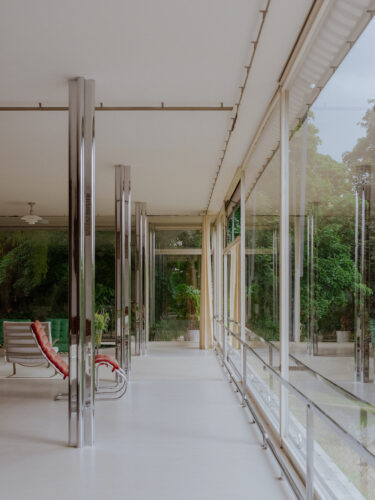Text & Interview Dzenana MUJADZIC | erschienen in CHAPTER №VII »NORMAL THINGS« – WINTER 2033/23
Mit seiner Serie zu Ludwig Mies van der Rohes’ Villa Tugendhat in Brünn demonstriert der in Paris lebende Fotograf Jean-Baptiste Thiriet, dass der gewählte Bildausschnitt einer Fotografie sehr viel persönlicher ist, als man auf den ersten Blick wahrnimmt. Wir sprachen mit ihm über Einschränkung als Stilmittel und wie man an Touristenmassen vorbeifotografiert.
Chapter Great photography usually goes beyond the physical and psychological boundaries of »what is seen in the frame«. What are the deciding factors when choosing your motif?
Jean-Baptiste Thiriet I think the primary gesture of photography is triggered by emotion and is perhaps the starting point of any image. It is this very personal aspect that dictates the act of photographing – be it a memory, an object, a color, a sound or a certain atmosphere. Common questions like »Why does one topic get more attention than another?« suddenly become more precise: »Why does this subject evoke an emotion in me?« and further »How will this emotion be perceived through photography?«



Chapter How did photographing a very popular and rather crowded tourist attraction like the Villa Tugendhat by Mies van der Rohe influence the actual outcome of the series?
Jean-Baptiste Thiriet The series dates from the summer of 2021 were I was able to obtain a slot to visit the villa at short notice. It’s a fairly touristy place and there were about thirty visitors there that day which made it impossible for me to frame too wide, so I concentrated on producing fairly tight images that better enhanced the general atmosphere, the materials and light rather than the strict study of the space. It’s also closer to my way of photographing, producing spontaneous images in natural light. This way the outcome ultimately turns out closer to a documentary work on architecture transporting the feeling of moving around and actually living there rather than simply being an architectural document.



Chapter In regards to this specific project, working with spatial limitations seems to fit right into your approach of »photographing less« – what do you mean by that?
Jean-Baptiste Thiriet It does, indeed. When visiting the villa, there were a lot of people on-site and time was limited. These two factors allowed me to adopt a more intuitive, more direct approach. Ultimately, these constraints defined the aesthetics of the entire series, alternating ambient views and details. This way of proceeding fits quite naturally with my desire to produce fewer images. For me photographing less is a way of living a little more in the moment, taking time, being more receptive to details and making more conscious choices even if it means discarding certain images.



Chapter Above all, what is the most important part of your creative process that defines you as a photographer?
Jean-Baptiste Thiriet From an aesthetic point of view, I have an interest in banal things, in everyday details, in markers of a territory, in nostalgia. As far as my way of thinking about photography is concerned, it ultimately always comes back to the time factor. Having slowed down my image production is perhaps the decision that has allowed me to make the most progress in my work in recent years – seeking coherence and no longer seeing photography as a visual succession but as a whole. For each new project, I find it important to define a framework, a narrative, striving to create images on the border between documentary and fiction.

